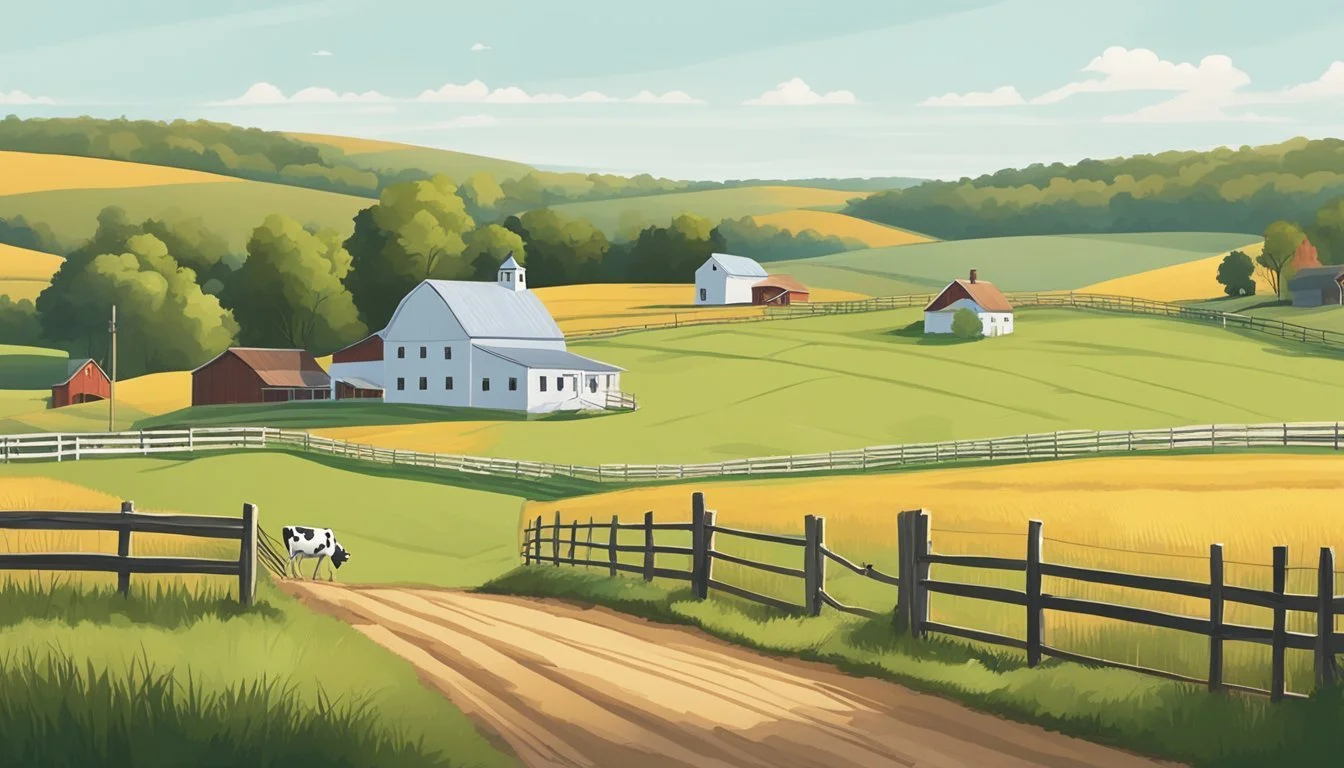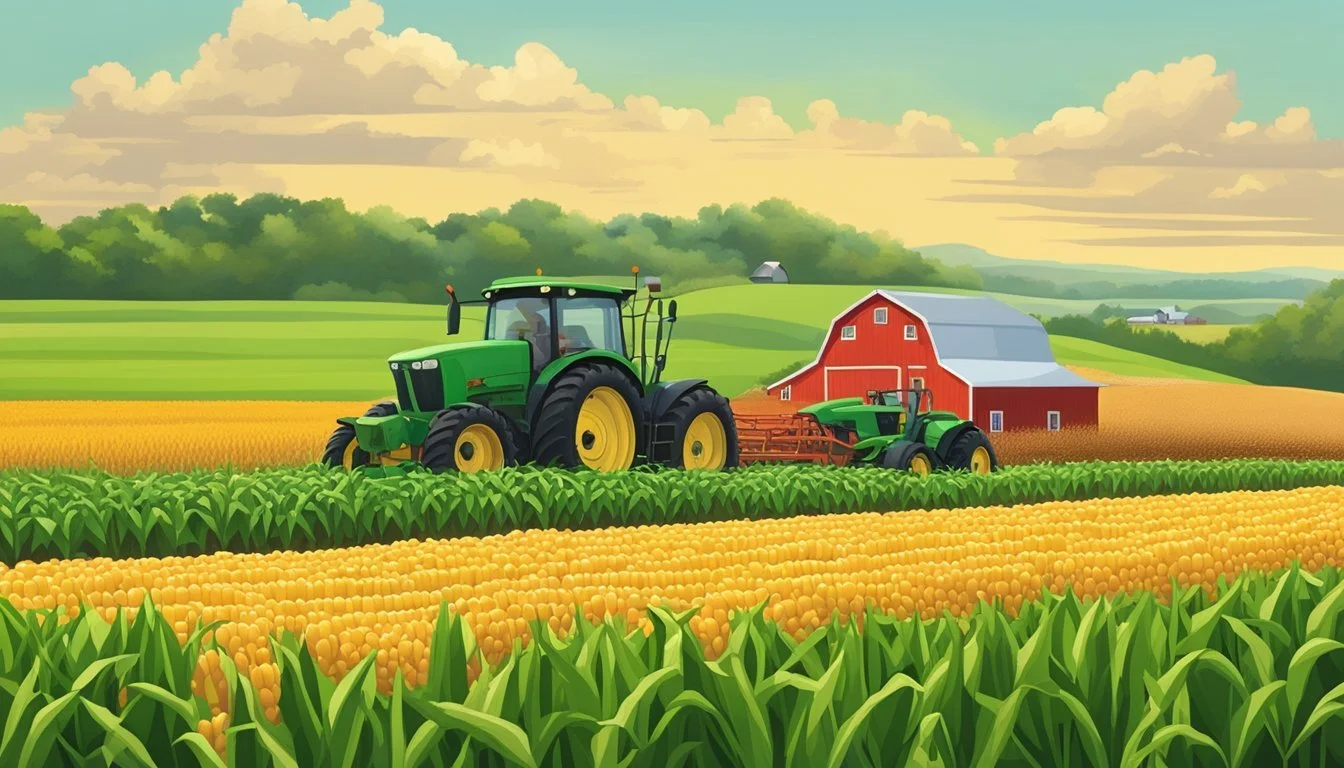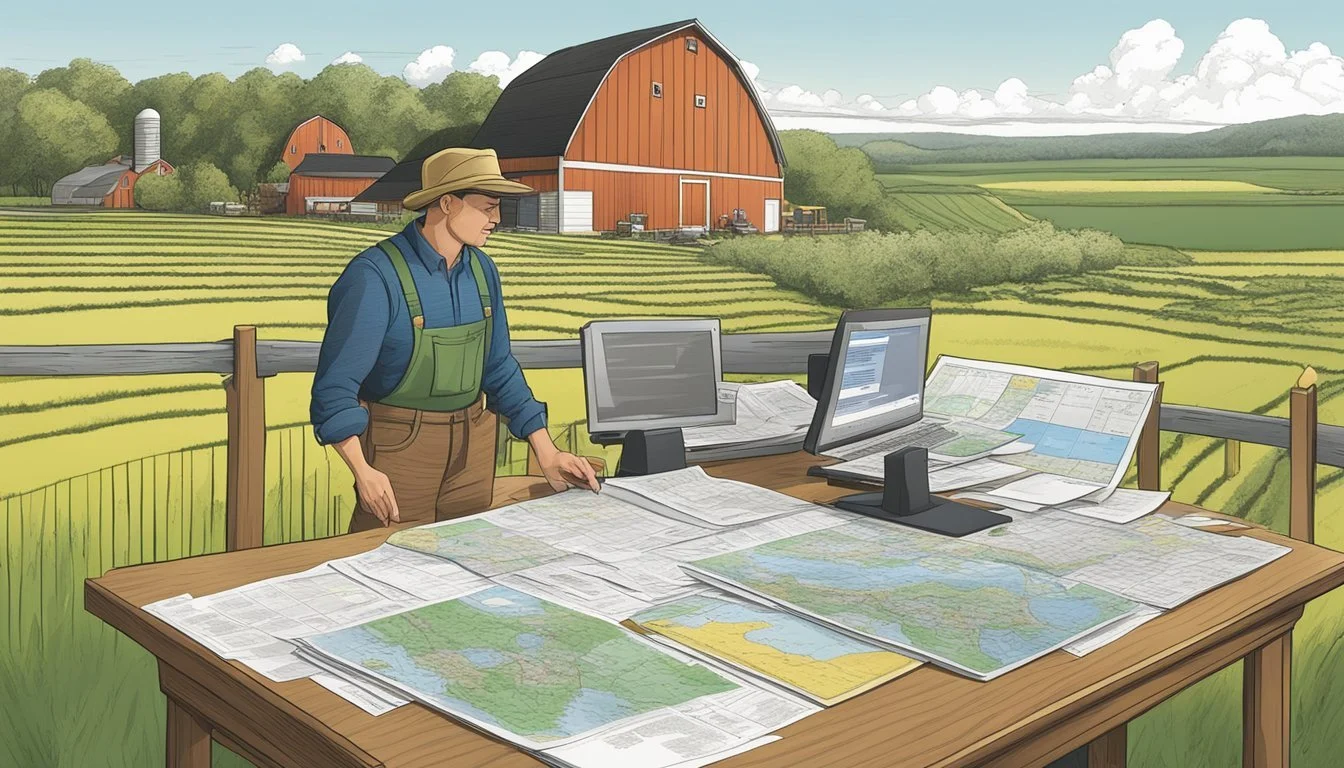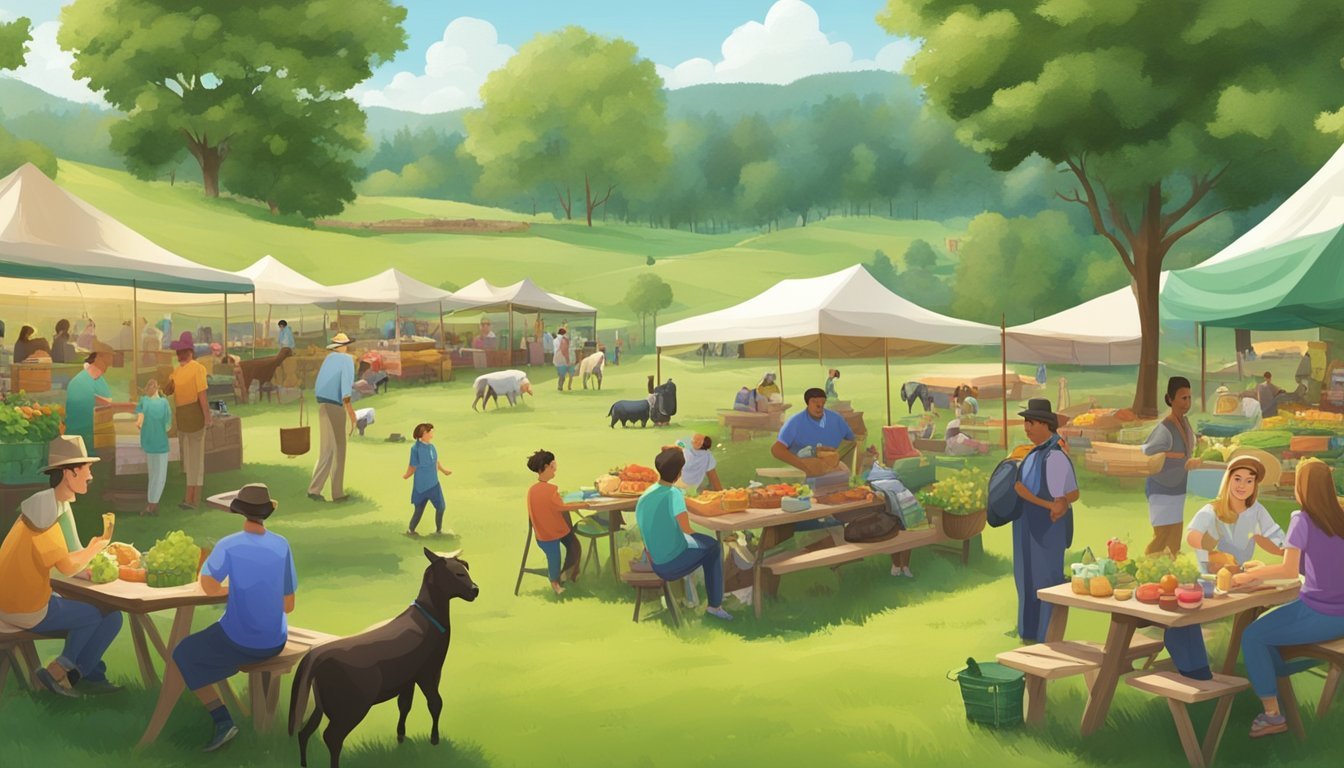Maryland Farm Land for Lease
A Guide to Your Best Agricultural Opportunities
This Article is Part of Our Guide on Navigating Agricultural Leases Across the US
Maryland offers diverse opportunities for those seeking farm land for lease. With its rich soil and varied climate, the state provides a fertile environment for a range of agricultural pursuits, from traditional crop farming to livestock grazing and specialty organic operations. The availability of farm land for lease in Maryland caters to both established farmers looking to expand and newcomers eager to embark on agricultural ventures without the initial high investment of purchasing land.
Interested lessees can find properties across Maryland, from the rolling hills of Harford County to the flat expanses of the Eastern Shore. Each region comes with its specific advantages, be it proximity to major markets or the benefits of specific micro-climates suitable for certain crops or livestock. Lease options may vary significantly, from small plots suitable for boutique farming to larger acreages capable of supporting extensive farming operations.
Leasing farm land in Maryland is a practical option for managing upfront costs while still reaping the benefits of the state's agricultural industry. As lease rates can fluctuate based on a wide range of factors including location, land quality, and market demand, prospective tenants should remain informed about current trends and opportunities. The structured approach of leasing also allows for flexibility, making it easier for farmers to adapt to the changing needs of the market and their business models.
Understanding the Maryland Farmland Lease Market
Maryland's farmland lease market reflects dynamic economic factors, a variety of lease types, and variable average lease rates. It plays a crucial role for both landowners and farmers, balancing the interests and obligations of each party.
Economic Factors Influencing Leasing
Leasing farmland in Maryland is shaped by numerous economic dynamics. The National Agricultural Statistics Service (NASS) reports that a significant portion of agricultural land in the state is leased, indicating robust activity in the lease market. Factors such as crop yields, market demand, and land availability in counties across the state influence leasing arrangements and rates.
Types of Farmland Leases
In Maryland, farmland leases can take several forms:
Cash Rent Lease Agreements: A fixed amount is paid on a per-acre basis, offering known income for the landowner.
Crop Share Leases: Landowners and tenants share the costs and profits of the crops produced.
Flexible Leases: These may be based on yields, prices, or a combination, providing greater adaptability.
These lease types are designed to meet the specific needs of both landowners and tenants, with considerations for the challenges unique to the region's agriculture.
Average Lease Rates in Maryland
The average lease rates vary across the state, with fluctuations depending on the land's attributes and market conditions. According to the University of Maryland Extension:
Non-irrigated farmland: Experiences an annual increase of approximately $3.36 per acre.
Irrigated farmland: Tends to see an increase of about $9.36 per acre each year.
Pastureland: Typically rises around $1.44 per acre annually.
These rates reflect the state's diverse agricultural landscape and the importance of understanding local market conditions when considering a lease.
Exploring Maryland Farm Land Availability
Maryland offers a variety of farm land for lease, catering to different agricultural needs. Tenants can explore properties ranging in size and lease terms, making it a versatile marketplace for prospective leasers.
Current Market Trends
The market for Maryland land for lease is dynamic, with properties available across various counties. There is a clear trend towards variable lease rates, depending on the acreage and county. For instance, rates can range from $1,800 per month for 0.1 acres in Baltimore County to $20,600 per month for 4 acres in Prince George's County. This variability indicates a market sensitive to location and land attributes.
Popular Counties for Farm Leases
In Maryland, certain counties stand out for their farm lease offerings:
Prince George's County: Known for larger plots, it's a sought-after location for leasing farm land.
Baltimore County and Harford County: Both counties have listings for small to mid-sized farm plots available for rent.
Washington County and Wicomico County: While specific lease rates are unlisted, they offer acreages for those looking for substantial farm land.
Finding Listings: Platforms and Resources
To browse Maryland farm land listings:
LandSearch: This platform shows a variety of properties for lease, with detailed information on acreage and location.
LandCashin: An online marketplace where users can sign up for Deal Alert notifications, tailored to specific land criteria.
Local Platforms: Often county websites and local land brokers provide listings for farm land available for lease.
Important Lease Agreement Considerations
Before entering a lease agreement for Maryland farm land, both landlords and tenants should be keenly aware of the agreement's legal, financial, and operational terms. The stability of the income for the landlord and the viability of the business for the tenant hinge on these essential considerations.
Legal and Financial Terms
Properly drafted lease agreements should spell out the terms in detail, leaving no room for ambiguity. They must define the rent or lease payments, outline how and when the payment is due, and specify the rights and responsibilities of each party. It's crucial to determine whether the lease is a fixed rental arrangement or structured on a share-rent basis where both revenue and costs are split.
Rental Amount: Clearly define whether the payment is set as a fixed amount, a percentage of the gross revenue, or a flexible rate depending on yields or prices.
Expenses: List which party is responsible for operational expenses such as maintenance, repairs, and improvements.
Risks and Returns
The nature of farming implies potential risks and returns, which are reflected in lease terms. For instance, share-rent leases might appear to distribute risk more evenly because both the landlord's revenue and the tenant's income fluctuate with the success of the crop or livestock. In contrast, cash rent leases generally place more operational risks on the tenant, with a fixed expense for the landlord, potentially stabilizing their income stream.
Risk Distribution: Identify how risk is distributed and ensure the terms are acceptable for both parties.
Income Potential: Assess the likelihood of profitability and be realistic about the potential income for both the tenant and the landlord under different market conditions.
Termination and Renewal Conditions
Termination clauses are vital in lease agreements, delineating under what conditions a lease might be terminated by either party. Additionally, details on renewal help to manage expectations and preparations for both sides as the end of the lease term approaches.
Notice Period: Indicate the notice period required before termination or before the end of the lease term.
Renewal Process: Outline the process and any conditions for lease renewal, including any potential adjustments to the terms.
Proper attention to the legal and financial specifics, a balanced approach to risks and returns, and clear termination and renewal policies are the cornerstones for a successful agricultural lease agreement in Maryland.
Maryland State and USDA Programs
Maryland offers a wealth of programs through state and USDA coordination, aimed at supporting the agricultural sector. These programs provide financial subsidies, encourage sustainable practices, and assist in farm planning and land acquisition.
Subsidies and Incentives
The USDA and the State of Maryland offer various monetary incentives and subsidies to support the agricultural community. Especially noteworthy is the Maryland Department of Natural Resources, which facilitates financial assistance for land planning and acquisition. This serves landowners looking to lease agricultural acreage and farmers in search of operational support.
Programs and Financial Support:
Agricultural cost-share programs for farm improvements
Grants for new and existing farming operations
Public funding for agricultural planning initiatives
Conservation and Sustainability Initiatives
The USDA Agriculture Conservation Easement Program in Maryland plays a pivotal role in promoting environmental stewardship. It provides technical and financial assistance, focusing on soil health, water quality, and habitat conservation.
Sustainability Efforts:
Wetland Reserve Easements improve water filtration, reduce flooding, and protect wildlife.
Soil health improvement programs to ensure long-term farm productivity.
Through these initiatives, Maryland reinforces its commitment to sustainable agriculture and the well-being of its rural communities.
Farming in Maryland: Types and Crops
Maryland's varied climate and soil conditions support a diverse range of agricultural operations. The state boasts a significant amount of agricultural land, catering to various crop-specific needs and fostering a rich tapestry of farm types.
Crop-Specific Land Requirements
Maryland offers a mix of farmland types, including pastureland and land suitable for crop production. Corn, a staple crop, thrives in conditions found across much of the state's arable land. Corn typically requires well-drained, fertile soils and is one of the widely cultivated acre crops in Maryland. Specific land requirements for corn include:
Acreage: Large plots are preferable for mechanized planting and harvesting.
Soil: Nutrient-rich, well-aerated, and pH-balanced soil enhances growth.
Topography: Flat to gently rolling topography is ideal for corn cultivation.
Diversity of Maryland Agriculture
Maryland's agriculture is characterized by its variety, with farms producing a range of crops beyond just corn. Its diverse agricultural output includes soybeans, (how long do soybeans last?) wheat, fruits, vegetables, and nursery products. The diversity is due to the state's various microclimates and soils. Key agricultural details include:
Types of Farms: Operations range from large-scale grain farms to small, organic produce farms.
Pastureland: Essential for livestock and dairy farming, complementing crop production.
Horticulture: Maryland supports a thriving sector, including nurseries and greenhouses.
This range of agricultural endeavors underscores Maryland's adaptability and the richness of its farming heritage.
Financial Planning for Farm Land Leases in Maryland
When engaging in financial planning for farm land leases in Maryland, lessees and lessors must carefully consider various factors that impact revenue, risk, and returns. The acreage and price of the land are foundational elements in crafting a lease agreement.
Rental Rates: Lessees should be aware of the dynamic nature of rental rates. For non-irrigated land, there has been an observed annual increase of approximately $3.36 per acre. For irrigated land, the escalation is around $9.36 per acre each year, and for pastureland, about $1.44 per acre annually. These figures assist in forecasting costs and planning long-term financials.
Cash Rental Rates: Determining cash rental rates necessitates attention to historical trends and projected growth. While annual adjustments are common, lessees must negotiate terms that align with their capacity to generate revenue from the leased land.
Risk Management: To mitigate risk, parties may consider flexible leasing arrangements such as share cropping or flex rent, where payments fluctuate with yields or prices. Diversification of crops or enterprises on the property can also spread risk.
Financial Returns: To enhance potential returns, lessees should conduct thorough analysis on the suitability of land for intended agricultural activities. Producers should calculate anticipated yields against expenses to ensure viability.
Key Financial Consideration Impact on Lease Planning Acreage Determines base costs Price Affects initial outlay Rental Rates Informs annual budgeting Cash Rental Rates Guides lease negotiations Risk Dictates lease flexibility
Effective planning combines historical data with prudent forecasting, assuring that arrangements are beneficial for both the landowner and the agricultural producer.
Membership and Community in Maryland Agriculture
In Maryland, the fabric of agricultural membership and community is tightly woven, characterized by cooperative efforts among farmers, local teams, and various organizations. The diversity of the agricultural sector fosters a sense of community where members actively participate in both cultivation and conservation practices.
The Department of Natural Resources plays a pivotal role in this community, offering guidance and support to ensure sustainable farming practices. They collaborate with agricultural landowners and leaseholders to optimize land use, while safeguarding natural resources.
Public participation is encouraged through community-supported agriculture (CSA) programs, which strengthen the connection between local farmers and residents. These programs enable members of the public to subscribe to the harvest of a certain farm, receiving a share of the produce throughout the farming season. This model not only supports farmers financially but also engages the community in the agricultural process.
Activities within the Maryland farming community are diverse, including educational workshops, farmer's markets, and environmental stewardship initiatives. These activities serve to enhance both the agricultural knowledge base and the communal bond.
Facilities such as educational centers and demonstration farms are integral to the Maryland agricultural landscape. They provide spaces where agricultural teams can demonstrate best practices, share knowledge with members, and host community events. These facilities often become hubs for innovation and collaboration in the agricultural sector.
In summary, Maryland's agriculture thrives on a community-oriented approach that emphasizes cooperation, education, and resource stewardship. Through active participation, members contribute to a robust agricultural network that benefits the entire state.
The Role of Technology in Farm Land Leasing
Technology has modernized the way landowners and farmers approach farm land leasing in Maryland, enhancing efficiency and informed decision-making. Specifically, online marketplaces and data analytics are changing how leases are found, negotiated, and managed.
Online Markets and Deal Alerts
In the context of Maryland farm land leasing, online marketplaces like LandCashin have empowered landowners and farmers to connect more efficiently than traditional methods. These platforms provide a centralized location where available properties can be listed and browsed. Landowners can specify criteria for their listings such as size, location, and price, making it easier for potential lessees to find a match.
Deal alerts are a feature often integrated into these marketplaces; they notify users when new listings meet their predefined criteria. This automation ensures that both parties are quickly informed of opportunities, which is crucial in a competitive market.
Data Analytics for Land and Crop Management
Data analytics plays a crucial role in the management of farmland and the crops produced. From assessing soil health to predicting market trends, technology enables landowners and lessees to make data-driven decisions that impact the profitability and sustainability of their operations.
Precise data can aid in determining the fair market value of land for leases, creating a transparent and informed marketplace. Both landowners and farmers benefit from this objective approach to negotiating lease agreements that competitively reflect the land's potential productivity.
In this digitized era, leveraging data analytics for land and crop management has become an indispensable part of the agricultural landscape, ensuring that Maryland's farmland continues to be used effectively and profitably.
Cultural and Recreational Aspects of Farm Land
Maryland’s farmland provides more than just a space for agricultural production; it is also a tapestry rich in cultural significance and recreational opportunities. These lands often host community events that strengthen local ties and celebrate the state's agricultural heritage.
Community gatherings, such as farmers’ markets and harvest festivals, are frequently held on leased farm lands. These events enable the public to engage directly with farmers, fostering a bond between consumers and the origins of their food. They also serve as venues for showcasing local crafts and traditions, adding to the cultural mosaic of Maryland.
Recreational activities on farmland may include corn mazes, hayrides, and u-pick events, allowing families to participate in agritainment. Many farms open their gates for school field trips and educational tours, promoting agricultural literacy among the youth.
Recreational Facilities Description Farm Trails Designated paths for walking, showcasing the natural beauty of the farmland and providing an idyllic setting for a leisurely stroll or cycle. Picnic Areas Spaces where the public can enjoy meals amidst the rural scenery, often positioned to offer picturesque views of the fields.
Farmland in Maryland also brings a palette of color with seasonal events, such as pumpkin patches in the fall and flower fields in the spring. These vibrant attractions draw in photographers and nature enthusiasts alike, highlighting the innate beauty of agricultural landscapes.
Moreover, leased farm land may feature on-site facilities such as barns or pavilions that can be rented for private events like weddings or family reunions, allowing these venues to serve as backdrops for personal milestones and celebrations deeply rooted in the pastoral charm of Maryland's countryside.
Transitioning from Landowner to Land Tenant
Transitioning from being a landowner to a land tenant in Maryland involves a strategic shift in mindset and responsibilities. Landowners considering leasing their agricultural land should engage in meticulous planning to ensure a smooth transition.
When leasing farmland, prospective tenants must thoroughly understand the lease agreements. These contracts vary and can be tailored to suit both the landlord's and the tenant's needs. It's crucial for both parties to set clear terms regarding the use of the land, duration of the lease, and the expectations for maintenance and improvements.
Key Considerations for Lease Agreements:
Duration: Determine the lease term and conditions for renewal or termination.
Rent: Establish the rent payment structure—fixed, flexible, or a combination.
Responsibilities: Outline who is responsible for land maintenance, repairs, and improvements.
Landowners should ensure that their lease agreements comply with state laws, which may mandate a minimum notice period for lease termination—for instance, at least six months' notice in Maryland.
Planning Ahead:
Research: Landowners should understand current market rates and leasing structures.
Legal: Both parties should consider legal counsel to review the lease terms.
Communication: Clear communication between owner and tenant can prevent future disputes.
By addressing the above entities and considering the legal requirements, planning transitions, and drawing up detailed lease agreements, landowners can confidently transition to becoming tenants while protecting their interests.
Pros and Cons of Buying vs. Leasing
Leasing farmland in Maryland offers several advantages, particularly for those starting out or expanding their operations. Leasing is generally more cost-effective short-term, diminishing the upfront financial burden. It enables farmers to utilize capital for other investments such as equipment, livestock, or crop inputs. The flexibility to negotiate lease terms, such as cash rent, flex rent, or crop share, allows for customization to a farmer's specific situation.
On the other hand, those who opt to buy farmland gain long-term stability and the potential for property appreciation. Owning land outright may also give farmers greater control over the use of the land and management decisions. However, purchasing involves a significant initial investment which could be a barrier to entry for potential buyers. It also exposes the owner to market risks, such as fluctuations in land value.
Buying Leasing + Long-term stability + Lower upfront costs + Potential land appreciation + Flexibility in lease terms + Greater control over land + Frees capital for other uses - Higher initial investment - Lack of ownership - Exposure to market risks - Potential lease terminations
Owners may also encounter additional responsibilities like property taxes and maintenance costs that lessees typically do not bear. However, lessees must acknowledge the temporary nature of their control over the land, as the lease may not be renewable or may change in terms with subsequent negotiations.
Both buying and leasing come with their own sets of advantages and downsides. Individuals should consider their long-term goals, financial situation, and tolerance for risk when deciding whether to purchase or lease farmland properties.
The Process of Securing Farm Land
Securing farm land in Maryland involves understanding the intricacies of agricultural leases and the economic landscape of local land. Leasing land affords both new and established farmers the opportunity to grow their operations within the state.
Negotiating Leases
When a farmer is interested in leasing farmland, negotiation is a critical step to ensure both parties—the landowner and the tenant—reach a mutually beneficial agreement. Key criteria to negotiate typically include:
Rental Rate: Determining the fair market value based on the quality, location, and history of the land.
Duration: Deciding if the lease will be annual or long-term to provide different levels of security and flexibility.
Terms of Use: Clearly outlining what agricultural activities are permitted on the land.
These elements lay the groundwork for a lease that aligns with both the tenant's agricultural plans and the landowner's expectations.
Understanding Local Land Economics
The state and county in Maryland have unique land economics which influence farmland availability and value. Factors involved include:
Marketplace Dynamics: Supply and demand affect the land's rental rates.
Agricultural Viability: Soil quality, climate, and infrastructure impact the land's farming value.
Prospective tenants should research these factors extensively to determine where the best opportunities lie and to guide negotiations. Leases must be crafted with consideration of local economic conditions to ensure long-term viability and return on investment.
Case Studies and Success Stories
Through careful planning and community involvement, Maryland has fostered remarkable success stories in farm leasing. These narratives not only inspire but also offer practical strategies for future agricultural entrepreneurs.
Successful Leasing Strategies
In Maryland, agricultural producers lease over 42 percent of all agricultural land. These leasing arrangements come in various forms to address the needs of both landlords and tenants. Case studies highlight how different structures—whether real estate, equipment, or livestock leases—can be tailored to benefit all parties involved. Teams in Maryland have illustrated that dynamic lease agreements can pave the way for sustainable agricultural practices and profitable farming operations.
Flexible Terms: Landlords and tenants often work together to agree on terms that offer mutual benefits, such as share cropping or flexible payment schedules.
Long-Term Partnerships: Some farms have established long-term leases that allow for the farmer to invest in the land with a sense of security and continuity.
Community Involvement: Trusts and local organizations sometimes facilitate land access for farmers, fostering community-supported agriculture.
Maryland Farms' Growth Stories
The growth of urban farms in Baltimore and other areas has become a beacon of agricultural innovation. Success stories accentuate how underutilized spaces are transformed into productive farms. These stories showcase the planning and collaboration necessary to navigate urban farming ventures.
Baltimore Urban Farm: Once a vacant lot, now a flourishing farm heralded for its contributions to local agriculture.
Revitalizing Land: Through strategic planning and community effort, previously disregarded plots of land have become centers for local food production and education.
By examining these case studies and success stories, one can glean valuable insights into the successful strategies for leasing farmland in Maryland.













